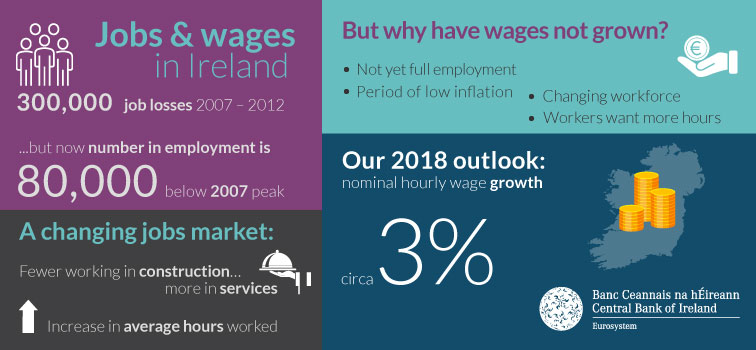Economic research on wage growth outlook
11 October 2017
Press Release

The Central Bank of Ireland has published the series of signed articles from the fourth Quarterly Bulletin, due to be published on 12 October 2017.
The labour market and wage growth after a crisis
This article (PDF 724.49KB) by Suzanne Linehan, Reamonn Lydon, Tara McIndoe-Calder, Paul Reddan and Diarmaid Smyth examines a range of labour market indicators to assess underlying labour market conditions and the factors driving wage growth, before considering some of the potential influences on future wage developments.
The article finds:
- Having shed over 300,000 jobs between 2007 and 2012, by the second quarter of 2017 the numbers in employment were just 80,000 below the pre-recession peak and employment has grown at its fastest rate in a decade.
- However, wage growth has remained subdued relative to pre-recession trends with little or no growth, until recently, in nominal hourly wage rates recorded at an aggregate level.
- Wage factors vary across sectors in the labour market. For instance, some sectors such as finance, professional activities and IT have both relatively high vacancy rates and higher wage growth, suggesting that labour tightness may be leading to stronger wage growth in those particular sectors.
- There are a number of potential reasons behind the post-recession weakness in wages, including temporary factors such as low inflation and changes in employment composition; for example, while employment has shifted away from construction, it has grown in sectors such as education, health, professional services, information and communications, and accommodation and food services.
- A further factor is how slack is measured for example, unemployment versus non-employment; in the first quarter of the year, around one-in-ten Irish workers reported they were willing to work up to 16 hours more per week on average. This suggests a greater degree of slack in the labour market than indicated by other measures and presents a potential drag on wage growth.
- While the rapid fall in unemployment may have led to expectations of wage increases, the historical relationship between wage growth and the unemployment rate does not necessarily support this. Institutional wage setting, a shift in the natural rate of unemployment, recession-related scarring effects and productivity all have a role to play.
- The paper finds that the degree of sensitivity of wages is higher during periods of low or high unemployment, outside of the 5-10 per cent range. Given the short term outlook for unemployment, this suggests a further moderate pick-up in wage inflation over the next year or so and nominal hourly wage growth of around 3 per cent is envisaged for 2018.
A short discussion on the findings of this research is available on our YouTube Channel
Strategic Stimulus: Analysis of Eurosystem Monetary Operations
This article (PDF 397.62KB) by John Graham, Anthony Nolan, and Paul Kane of the Bank’s Financial Markets Division, reviews the Eurosystem’s monetary policy stimulus activities throughout 2016 and the first half of 2017 and analyses the impact of these measures on Eurosystem liquidity provision and liquidity conditions. For context, it also considers the measures brought forward by other major central banks as well as the debt capital market activities of the Irish government and Ireland’s main domestic banks.
The article finds:
- Throughout the period, excess liquidity continued to rise across the euro area, primarily driven by purchases under the Asset Purchase Programme (APP) and continued participation in the final rounds of the Targeted Longer Term Refinancing Operations (TLTROs).
- Eurosystem lending increased over the period due largely to the take up in TLTRO-II operations. In contrast, the total amount borrowed through Main Refinancing Operations (MRO) declined by over €77 billion between the start of 2016 and the middle of 2017. Throughout 2016, liquidity provided through Eurosystem refinancing operations continued to be in favour of TLTRO lending.
- Levels of excess liquidity continued to grow, reaching €1,633.1 billion at the end of June 2017, up from €654.5 billion at the start of 2016.
- Current account holdings in excess of minimum reserve requirements averaged €567.3 billion for 2016, more than twice the level for 2015. The trend continued into 2017, with the figure reaching €937.1 billion for the year to end of June 2017.
- Irish domestic banks continued to reduce their level of central bank funding mainly due to increased access to debt capital markets in areas such as covered bond issuance and balance sheet deleveraging.
- Irish government bonds performed strongly, with spreads narrowing against German and French benchmark bonds throughout 2016 and the first half of 2017.
Notes
The views expressed in these articles are not necessarily those held by the Central Bank of Ireland.